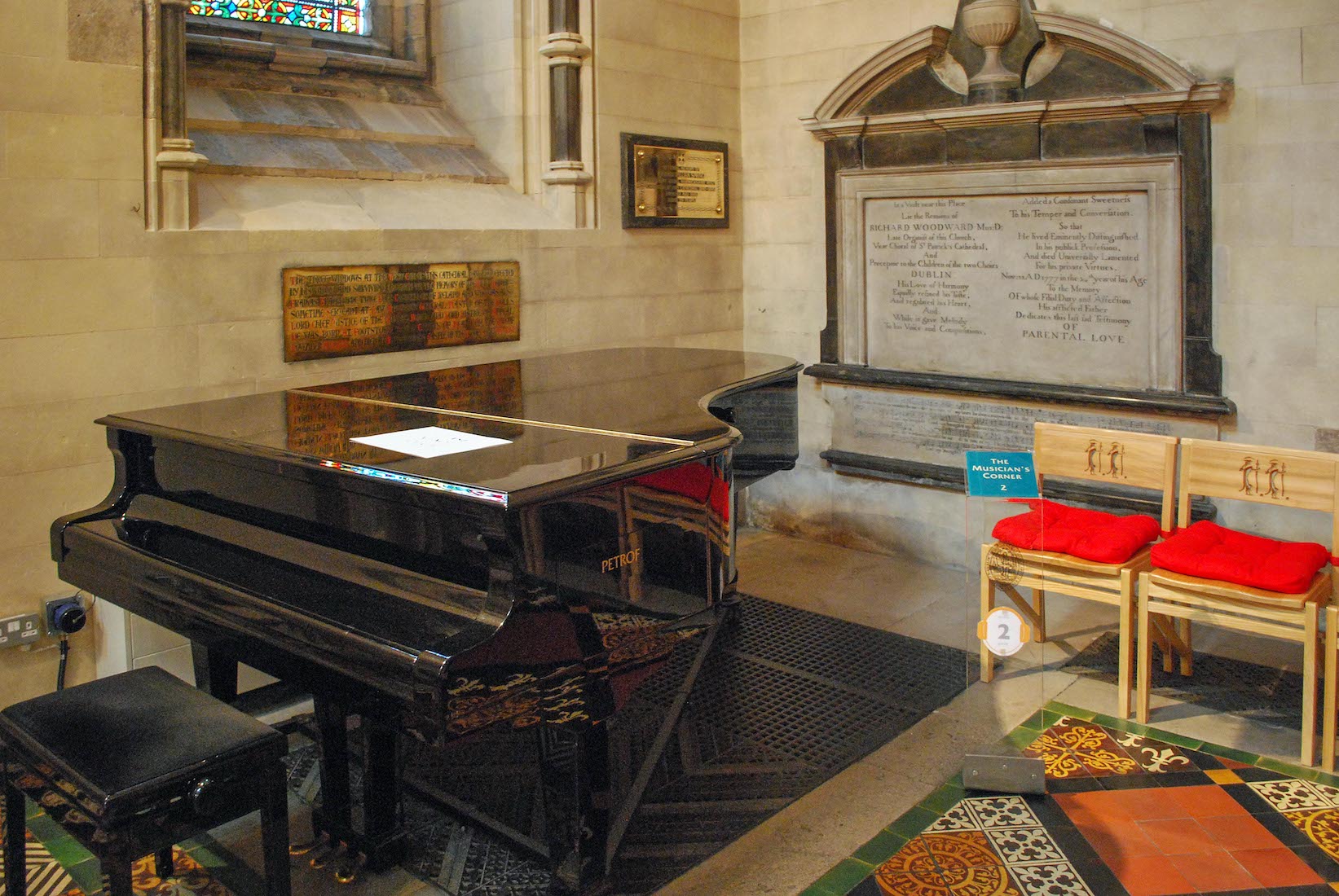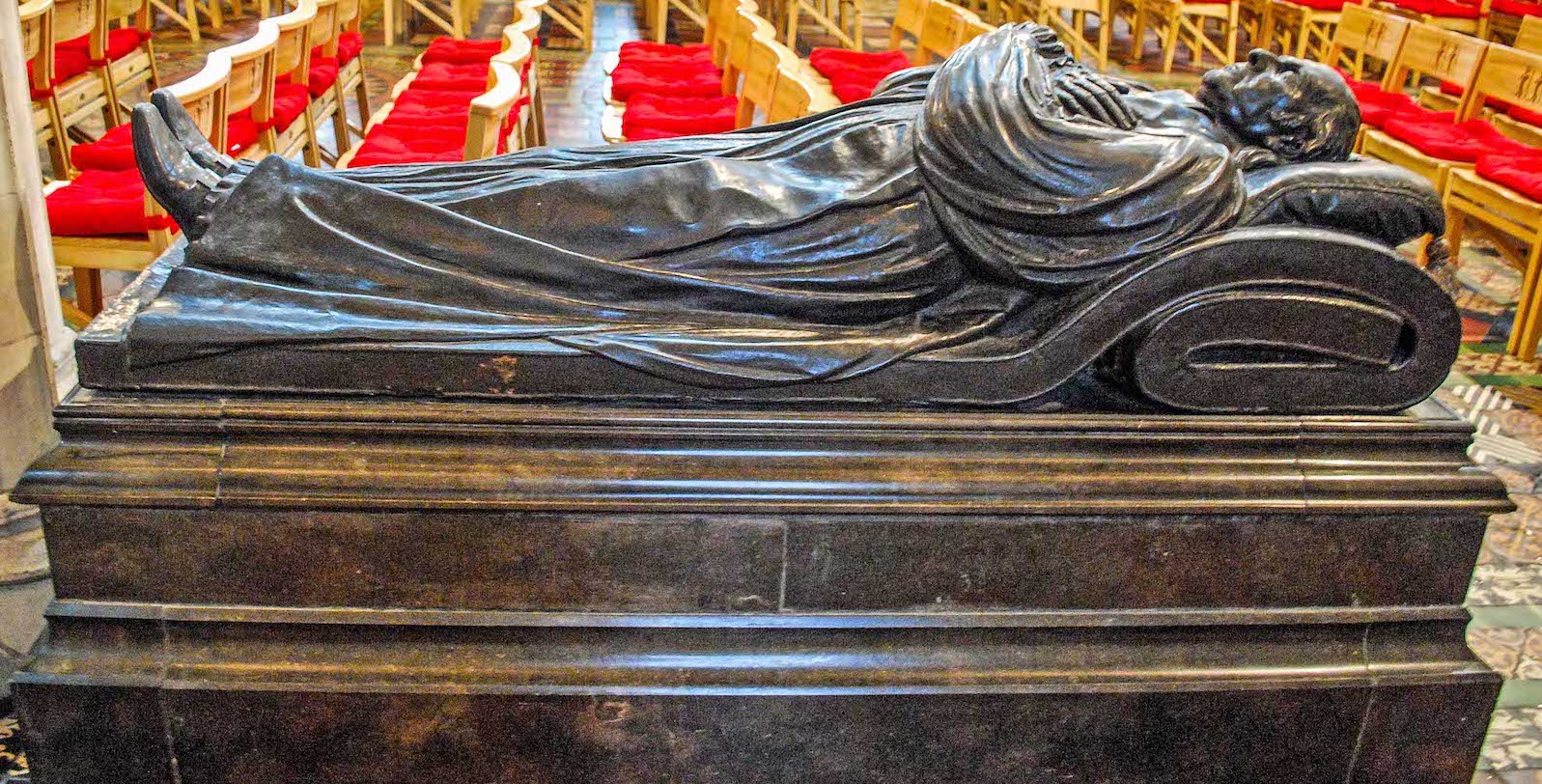
As we enter through the South door from outside, we have the option of turning left or turning right. To our right is the entrance to the Cathedral. To our left, a flight of stairs leading to the Synod Hall Bridge. INDEX
22. LOOKING UP TO THE SYNOD HALL BRIDGE GSV GSV


Straight ahead of us on the opposite wall (Photograph 1) is a memorial for Thomas Prior. Thomas Prior (1680 – 1751) was an Irish author, known as the founder of the Royal Dublin Society. •• Before entering the Cathedral we take a quick look at the Synod Hall Bridge. A flight of steps leads up to iron gates (Photograph 2), behind which is a three-light stained glass window. Beyond the gates, further steps lead up to the right. There are also three round windows on the sides of this entryway.
23. BRIDGE WINDOW AFB (X3)
The three lights of the facing window contain a lot of abstract material, but also several recognizable figures and events. On the left is St Peter carrying the Keys of the Kingdom. On the right is St Paul, often depicted, as here, with a sword. At the top of the central light is an image of the glorified Christ, and below the dove descending and the tongues of fire at Pentecost.
24. BRIDGE ROUND WINDOWS AFB AFB GSV
These three attractive windows are on the walls of the cathedral steps up to the Bridge: the top two on the Eastern side, and the third on the Western side. The windows illustrate: •• The seven Gifts of the Spirit (wisdom, understanding, counsel, fortitude, knowledge, piety, and fear of the Lord) with Sophia pictures; •• The Good Shepherd with the seven Fruits of the Spirit (love, joy, peace, long suffering, gentleness, goodness, faith, meekness, temperance); •• Charity.
25. BRIDGE CENTRE LM
We follow up the steps to the top of the bridge. Here we find a tall lancet window on each side with an arched roof above. Beyond there are doors, within the bridge, leading into the Dublinia Museum. Click here to look at this Bridge walk in more detail.
26. WEST NAVE AISLE GSV W
As we enter the Cathedral we step into the wide aisle across the back of the Cathedral. To our left is a display of useful guides in various languages, and a wonderful old chest – sure to be full of gold pieces! We notice too the assortment of colourful floor tiles; we shall find these are a memorable feature of Christ Church Cathedral. Notice that there is a single window in the wall at left, and in fact a similar window on the far side of the Cathedral. [Photo2 Credit: Wikipedia Sailko]
27. NAVE LM
Moving across to the central nave aisle we turn and look towards the sanctuary. Gothic arches with solid columns march away towards the front, with a small triforium layer above, and then larger clerestory windows at the top. The original 13th century nave vaulting collapsed in 1562, and was restored by George Edmund Street in the 1870s, largely following the original design.
28. WEST WALL LM LM
Walking to the front of the central aisle and looking back, we observe the monuments on either side of the west door. We shall return to the Great West Window close to the end of our tour.
29. NAVE TILING LM
In most cathedrals it is good advice to look up, but here we need to look down to take note of the wonderful floor tiles of the Cathedral. You will be captivated by the colourful and often charming depictions, showing intricate geometric designs, strange beasts, heraldic symbols and of course the famous Foxy Friars – anthropomorphised foxes wearing the garb of a medieval pilgrim and carrying a pilgrim's staff. Although there are a number of original tiles dating back to the medieval period, others are later reproductions of the originals, laid down during the large-scale renovations of Christ Church in the late 19th century. The tiles are beautifully artfully designed, and each tells it's own story. They add stunning bursts of colour to the Cathedral, and help to create a real sense of grandeur.
30. WEST WALL SIDE WINDOWS AFB AFB
We look at the two smaller windows on the West wall. •• The window on the South side (left) depicts Shadrach, Meshach, and Abednego in the fiery furnace, protected by an angel, (lower section) and Daniel in the den of the lions (upper section). •• The window on the North side ( right) depicts Cain and Abel at top, and Adam naming the animals below. •• Both windows were cartooned by John Hardman Powell (1827 – 1895) and executed by Hardman and Co.
31. WESTERN MONUMENTS W GSV
There is a monument on either side of the West door. The monument at left remembers Thomas Abbott who gave his life to helping the poor and destitute of Dublin. The monument shows a weeping orphan girl standing by an urn •• General Samuel Auchmuty (1756-1822) came from a Scots-Irish family that had migrated to the American colonies; he was actually born in New York City. But he and his family were Loyalists, and he eventually chose a career in His Majesty's Army which took him literally around the world. He fought in campaigns in India, in the South Pacific, and in South America, and eventually accepted a post here in Ireland where he became a regular communicant at Christ Church. [Photo1 Credit: Wikimedia Sailko]
32. MUSICIAN’S CORNER LM GSV
We walk across the Cathedral to the Northwest corner – the Musicians’ Corner. This corner, commemorates the musicians of the Cathedral. In 1480, Thomas Bennett, son of Lord Mayor of Dublin, endowed the Cathedral to sustain four choristers. The Cathedral today continues to provide fine music of every century for the Eucharist and Evensong. •• Just East of the Musicians’ Corner, an iron gate in the North wall opens into ...
33. THE BAPTISTRY LM(X3)
The handsome baptismal font rests on a base of eight pillars in alternating marbles. The circular font is adorned with quatrefoils, all with the same central cross. Each cross is surrounded by four circular decorative pieces, with a varied choice of floral motif. The font is capped with a font cover with beautiful metalwork. The noteworthy feature of the font is that it contains a piece of every type of marble found in Ireland.
34. BAPTISTRY WINDOWS I MR (X5)
There are ten single-lancet windows in the baptistry, each depicting a saint. From left to right we have: St George, St Edmund, St Cormac, St Laurence O’Toole, St Bridget, ...
35. BAPTISTRY WINDOWS II MR (X5)
... St Patrick, St Cuthbert, St Finbar, St Mary, and St Anne. The text below is not all clear, but reads: ‘To ... in pious memory of his dearly beloved (wife?) Bessie Mary Anne who departed Mar VI MDCCCLXXVI [1876]. The windows in this baptistry were glazed by George Edmund Street, architect of this Cathedral Church.’ Laurence O’Toole was the second Archbishop of Dublin.
36. NORTH AISLE LM
Leaving the baptistry, we continue along the North aisle. Notice the small Canterbury cross at left: these were given out by Canterbury Cathedral in 1932 to all Anglican Cathedrals as a sign of fellowship and communion. The floor tiles continue to amaze us. On the right is a black tomb and effigy.
37. BISHOP’S TOMB LM
The tomb and effigy are of of Charles Dalrymple Lindsay, bishop of Kildare and dean of Christ Church. He died on August 8th,1846.
38. NORTH NAVE WINDOWS AFB (X4)
There are four stained glass windows along the North nave wall. From left (West end) we have: •• Noah (below), Melchizedek (above); •• Isaac (below), Jacob (above); •• Joseph (below), Moses (above); •• David (above), Samuel (below). All windows cartooned by John Hardman Powell (1827 1895), Executed by Hardman and Co.
39. LECTERN AND PULPIT LM
This brings us to the front of the nave with the lectern and the pulpit. And some more excellent tiling! For many cathedrals this would be the crossing, but in this Cathedral, the crossing is further East, occupied by the choir stalls.
40. THE BRASS EAGLE LM AMT
The lectern is a conventional brass eagle lectern, of a style found in many cathedrals and churches. Despite their frequent occurrence, there is no convincing explanation of their beginnings, apart from tradition. There is talk of the eagle being the highest flying bird, of Isaiah 40:31 and soaring with wings as eagles, and of the Evangelist John having the eagle as his symbol. I find none of these convincing.












































